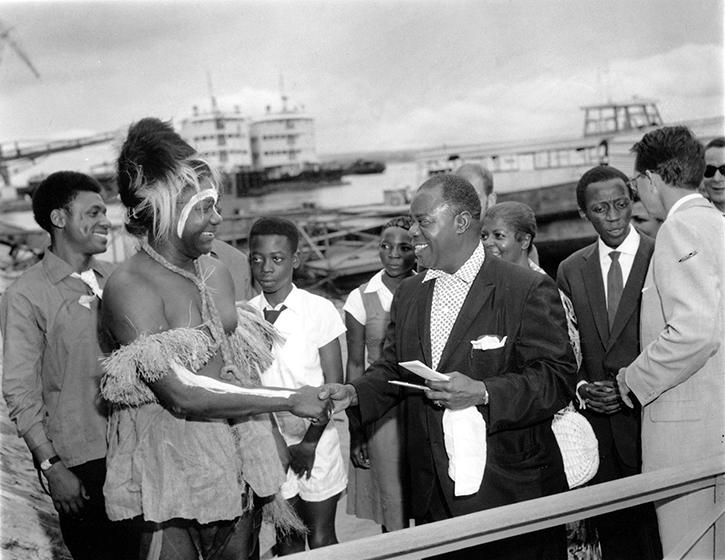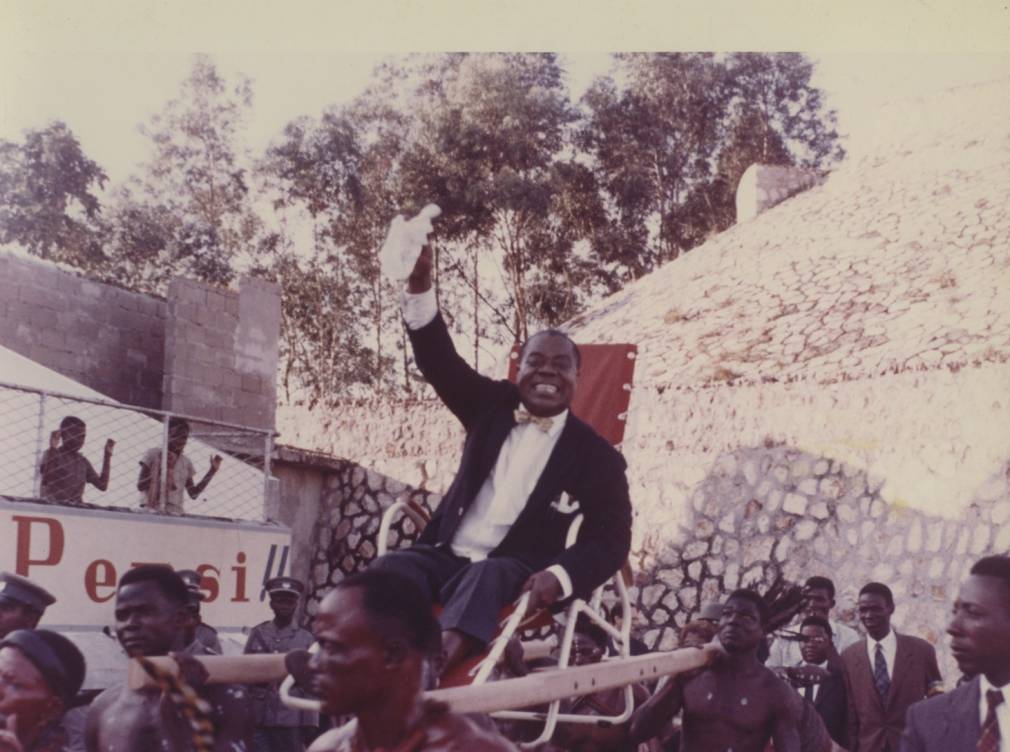Rejoice,
Destiny (God) wanted you to visit the land of your friends
Our country, named the Congo, is in the heart of Africa
Armstrong,
Elsewhere you are called Satchmo
In the Congo, we call you Okuka Lokole
These are the words to a song written by Grand Kalle and his African Jazz to celebrate the visit of the world-famous jazz trumpeter to the Congo, which had become independent several months before.According to the Congolese writer Clément Ossinondé, “Louis Armstrong set foot in Leopoldville on October 28, 1960, arriving from Brazzaville. He was welcomed to the capital of the former Belgian Congo by Albert Mongita Likeke, the director of cultural affairs at the time, who was dressed for the occasion in traditional costume.”
Like Albert Mongita Likeke, Louis Daniel Armstrong was also an actor, as attested by his lengthy filmography. In a short film made in 1932, A Rhapsody in Black and Blue, he is even seen wearing a leopard skin, the same attire that is often part of the traditional dress worn by Congolese chiefs. Indeed, Mobutu’s famous toque was made of leopard skin. (Editor’s note: In the film Rhapsody in Blue, Satchmo no doubt did not choose himself to wear this costume. In Hollywood, this was the beginning of the era of “jungle movies”, a genre conveying all sorts of clichés. Nevertheless, as the writer noted, the leopard is a distinctive sign of power in the Congo.)
In any case, in 1960 Armstrong was welcomed like a head of state. In the stadium where he was to give a concert, he arrived on a chair born aloft by his African brothers in traditional costume. Far from the notorious imagery of Tintin In the Congo, this practice was reserved in precise circumstances for great leaders and other important personalities.

Armstrong, King of the “Jazzers”
Moreover, it was a somewhat “official” visit of sorts, since the the musician had been chosen by the State Department to play the role of American cultural ambassador (like Benny Goodman and Dizzy Gillespie). Uncle Sam’s America, at the height of the Cold War, helped to organize “Ambassador Satch’s” tours of Europe and Africa (he played in 27 cities there) where his music, as well as his image, were well-known.
In Leopoldville, the man and his trumpet were seen everywhere – before he even set foot in the Congo – on billboards and ads for an American soda (not the one from Atlanta, its competitor) which co-sponsored with the State Department his trip to the Congo. Armstrong embodied a black modernity, which the very word jazz conveyed. At the time, the coinage “jazzer” designated an elegant person, in reference to the suits jazz musicians wore on stage. And even if Congolese music has its foundation in the rhumba – which was created in the Congo and then ricocheted back modified from Cuba – it is not uncommon to see the word “jazz” in a band’s name, as was the case for African Jazz and Ok Jazz, two of the most popular groups in the Congo in the 1950s.
If Satchmo (literally Satchelmouth) had already played several times in Africa (and notably in the Gold Coast shortly before it became Ghana), he was more at home in the Congo than elsewhere, in the land of his ancestors. Symbolically at least… Grandson of former slaves, Louis, born in New Orleans on August 4, 1901, grew up in this southern city strongly marked by segregation. His family lived in Backatown, a poor and violent neighborhood. As in Kinshasa, music was everywhere. There is even a place (now a public garden) in New Orleans called “Congo Square”. This public square made its mark on the history of the slave trade as far back as French Louisiana, as this was where the slave market was held and also where the slaves were allowed on Sundays to sing and dance their suffering and hopes. Over time, this square became one the key birthplaces of African-American culture. And in 1980 (after seven years of construction), the large public garden surrounding Congo Square was opened and named Louis Armstrong Park. But let’s go back to 1960 and Satchmo’s visit to the Congo.
A Song for the Child of Congo Square
As is the custom for the Bantu peoples, important events are immortalized in music. On the occasion of the American musician’s memorable visit to Leopoldville, Joseph Kakasele, nicknamed “Grand Kallé”, the father of modern Congolese music, sang with his African Jazz “Satchmo okuka lokole”. The song is sung in Lingala. But “Okuka lokole” is from Tetela, a Bantu language spoken by the Batetela. This ethnic race of the Anamongo group is located east of Kasai, on land irrigated by the Lomami and Sankuru rivers. The singer Papa Wemba and Patrice Emery Lumuma, the separatist leader, are famous figures of this ethnic group.
The lokole is a long section of hollowed-out tree trunk and carved with a narrow slot. This type of drum is used as a musical instrument or for sending messages. The idiophone instrument produces sounds by being struck on both sides of the slot with wooden sticks. Widespread among the Bantu peoples, the lokole is often compared to morse code. For the Batetela, this large drum plays a special role. “Okuka” in their language is a resistant tree ideal for fabricating lokole drums. It is also one of their surnames.
O o Armstrong Okuka, o o Satchmo (x2)
“Satchmo, Okoka lokole” by Joseph Kabasele
You have come to your people
We welcome you, we welcome you, Okuka Lokole
O Lokole, Lokole, welcome to you, Okuka Lokole
Receive the salutations of the Congo, friend e e
O o Armstrong Okuka, o o Satchmo (x2)
After his triumphant welcome and his concert in Leopoldville, he traveled to the Katanga. This mining province seceded in July 1960, just days after the proclamation of the Congo’s independence. Backed by Western powers, Moïse Tshombe proclaimed himself president, and with the aid of the Belgians, defended with weapons the secession from the Congolese authorities. Certain sources report that a one-day cease-fire was decreed to allow people from both sides to attend a concert by Louis Armstrong. He himself later said, humorously, that he had put an end to the civil war. All this probably did not trouble the hardy musician used to the havoc in the clubs of Chicago where it was not uncommon to see musicians continue to play onstage during a settling of accounts between rival gangsters. But did he know that while he was in the Congo the Prime Minister Patrice Emery Lumumba and two other political figures, Joseph Okito et Maurice Mpolo, had just been arrested ? These three Congolese patriots were later assassinated in Tshombe’s Katanga in January 1961, three months after the departure of “Ambassador Satch”… and with the benediction of the CIA.
The virtual Louis Armstrong House Museum features several documents online about Satchmo’s visit to the Congo.
Find José Nzolani’s books on his site.




